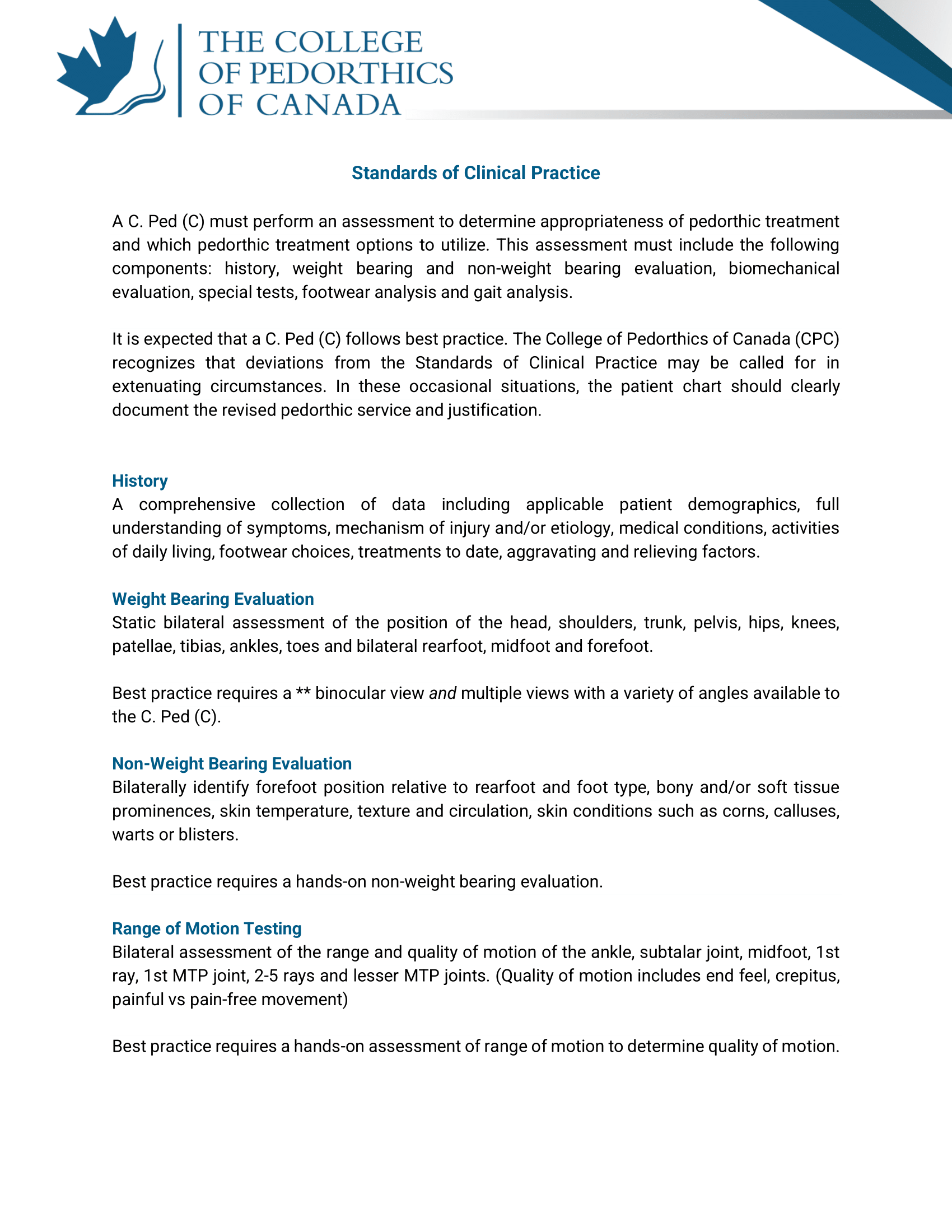A C. Ped (C) must perform an assessment to determine appropriateness of pedorthic treatment and which pedorthic treatment options to utilize. This assessment must include the following components: history, weight bearing and non-weight bearing evaluation, biomechanical evaluation, special tests, footwear analysis and gait analysis.
It is expected that a C. Ped (C) follows best practice. The College of Pedorthics of Canada (CPC) recognizes that deviations from the Standards of Clinical Practice may be called for in extenuating circumstances. In these occasional situations, the patient chart should clearly document the revised pedorthic service and justification.
A comprehensive collection of data including applicable patient demographics, full understanding of symptoms, mechanism of injury and/or etiology, medical conditions, activities of daily living, footwear choices, treatments to date, aggravating and relieving factors.
Static bilateral assessment of the position of the head, shoulders, trunk, pelvis, hips, knees, patellae, tibias, ankles, toes and bilateral rearfoot, midfoot and forefoot.
Best practice requires a ** binocular view and multiple views with a variety of angles available to the C. Ped (C).
Bilaterally identify forefoot position relative to rearfoot and foot type, bony and/or soft tissue prominences, skin temperature, texture and circulation, skin conditions such as corns, calluses, warts or blisters.
Best practice requires a hands-on non-weight bearing evaluation.
Bilateral assessment of the range and quality of motion of the ankle, subtalar joint, midfoot, 1st ray, 1st MTP joint, 2-5 rays and lesser MTP joints. (Quality of motion includes end feel, crepitus, painful vs pain-free movement)
Best practice requires a hands-on assessment of range of motion to determine quality of motion.
Perform special tests bilaterally on structures and areas relevant to the client’s condition.
Best practice requires special tests to confirm suspected condition and to rule out differential diagnoses prior to the pedorthic treatment plan being implemented.
Evaluate appropriateness and fit of current footwear, including upper deformities, tread wear pattern, sockliner wear patterns and any abnormalities noted when standing and walking bilaterally.
Bilateral assessment of the dynamic position, range and quality of motion of the following structures during all phases of the gait cycle: head, shoulder, arm, trunk, pelvis, hip, knee, patella, tibia, subtalar joint, calcaneus, midfoot, forefoot, hallux and lesser toes.
Best practice requires a ** binocular view and includes multiple views and a variety of angles available to the C. Ped (C).
Educate clients on how assessment findings and/or lifestyle contributes to current symptoms. Discuss treatment options with an explanation as to how each option would address the client’s needs. Discuss follow-up protocol. Based on the findings of the assessment, the C. Ped (C) will specifically outline the parameters of design, materials, composition and fabrication of foot orthotics intended to treat the patient’s unique medical needs when this treatment is indicated.
Custom foot orthotics must be manufactured from a 3-dimensional cast and/or scan that, when taken, is able to be evaluated by a C. Ped (C) in real-time.
Scanning technologies must not use computer algorithms, artificial intelligence extrapolations and/or interpolations to calculate contours from 2-dimensional pressure readings, ink impressions, single aspect photographs or any other 2-dimensional methods.
Mirror imaging of casts is not permitted.
A 3-dimensional cast and/or scan must reasonably capture the complete volume of the plantar, posterior, medial and lateral anatomy of the foot relative to the depth of the custom orthotic being provided.
To satisfy the custom-manufactured criteria, each foot requires a 3-dimensional scan or physical cast and must be processed individually and not be subject to batch processing, library or best-fit systems. The final orthotic shell must be unique to each foot throughout the entire process of manufacturing the device.
Best practice requires that a C. Ped (C) dispenses all custom products in-person. In the event that a C. Ped (C) cannot be present, follow-up care should be offered within a timely manner either in-person or through video consultation.
In-person dispensing is mandatory for high risk clients. This includes but is not limited to neuropathy, wound, amputation, leg length discrepancy.
The C. Ped (C) must offer follow-up communication to evaluate the effectiveness of pedorthic treatment. High risk clients should be accommodated with more timely and face-to-face communication. In the event of adjustments being needed to orthotics, you must be available to your client in a timely manner.
Best practice is to follow-up at 3 weeks, 6 months and one year after dispensing custom products.

 Standards of Clinical Practice PDF
Standards of Clinical Practice PDF